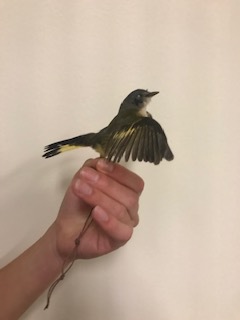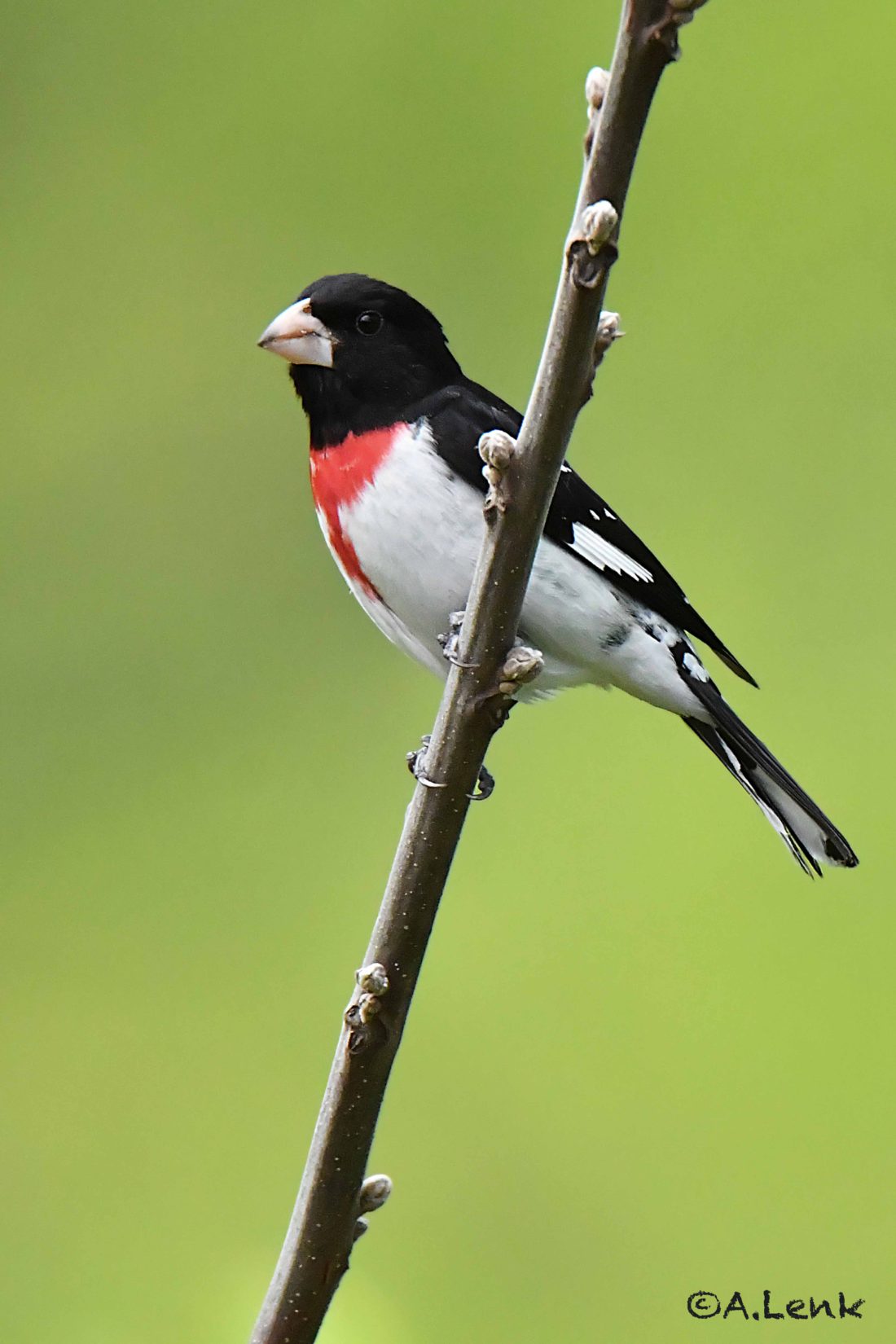On an upper floor of Zeis Hall on the UNC Asheville campus is a small room containing many birds. None of these birds are alive. Each one is dead, preserved through taxidermy and stacked side by side in individual Tupperware containers.
The room, smelling faintly of formaldehyde, is a biological specimen laboratory. The collection is being preserved by Paulina Jones, a senior studying environmental management and policy. Each bird in her assemblage — an American redstart, a hermit thrush, a yellow-rumped warbler — is the victim of a window strike on the UNCA campus.
People sometimes see birds attacking their own reflections in windows. But birds also collide with windows in midflight due to confusion. At night, birds can see indoor light sources but can’t tell that they’re behind windows. And during the day, transparent glass means birds can see through to vegetation on the other side; mirrorlike reflectivity on windows can lead birds to see trees or clouds on the glass itself and attempt to fly toward them.
Bird strikes are a problem anywhere buildings exist. But Asheville happens to be an avian hot spot due to its location on a major migratory highway for birds heading to and from Central and South America called the Atlantic Flyway. Western North Carolina is a prime bird-watching location for locals and tourists, and travel guides tout spots along the Blue Ridge Parkway and the Beaver Lake Bird Sanctuary in North Asheville.
While some of WNC’s bird species reside here year-round, most of the area’s feathered friends are just passing through. Three-fourths of bird species migrate, and the region’s heavy vegetation makes it a palatable spot to stop, explains Tom Tribble, former president of the Blue Ridge Audubon Chapter, which maintains the Beaver Lake sanctuary.
Yet Asheville’s tall buildings and their many floors of windows can make the area particularly deadly to these avian tourists. To prevent bird strikes from occurring on the birds’ migratory journey, the Coalition for a Bird-Friendly Asheville — a team of bird lovers from the UNCA Audubon chapter (including Jones), the Blue Ridge Audubon chapter and other groups — asked Asheville City Council on Aug. 24 to consider a “lights out” program for city-owned buildings in downtown.
Better in the dark
Many lights-out initiatives are voluntary. For example, Georgia Audubon encourages citizens and business owners to turn off lights at night during the spring and fall migration every year. In New York City, the annual 9/11 tribute — two shafts of blue light rising into the sky — is temporarily shut off for 20 minutes at a time so birds attracted by the beams can disperse.
The Coalition for a Bird-Friendly Asheville, by contrast, wants a formal policy here. “Our request for a lights-out initiative is that all city-owned buildings turn off nonessential — not necessary for safety or work — indoor lighting from 11 p.m.-6 a.m.,” says Sarah Branagan, a member of the coalition and president of the UNCA Audubon Asheville chapter. “While this program could be voluntary in practice, we are specifically looking for the adoption of a new policy to require this for city-owned buildings.”
Speaking to Council on Aug. 24, Branagan — who became passionate about eliminating bird strikes after witnessing a juvenile veery, a type of thrush, hit a window on campus — suggested that city-owned buildings turn off unnecessary lights during the fall and spring migration seasons. She also suggested redirecting certain upward-facing lights downward so as not to disorient birds.
“I’m especially hopeful about the lights-out program because that would not only save the city money but help out the birds as they’re either coming through or living here all the time,” says Branagan. “It’s a win-win.”
In a statement to Xpress, Mayor Esther Manheimer says she supports further consideration of a lights-out initiative. “I am glad to see strong advocacy around sustaining migratory bird populations,” she says. “The city could review whether there are any nonessential nighttime lights in and around municipal buildings that are not already shut off at night to support this effort, as well as encourage businesses and community members to do the same.”
Coalition for a Bird-Friendly Asheville is not the first group to raise local awareness of bird strikes. In fall 2019, the National Audubon Society partnered with Global Bird Rescue, a project of Fatal Light Awareness Program Canada, on an informal count of dead or injured birds in downtown Asheville during a migratory period. According to Susan Richardson, an at-large board member for Blue Ridge Audubon, the team found three dead birds and zero injured birds in downtown Asheville during a one-week period in October.
Ground truthing
More rigorous data presented by the Coalition for a Bird-Friendly Asheville at the Council meeting, however, suggested that local bird strikes are much deadlier than the previous count suggested. Jones from UNCA offered the results of her senior project, which studied strikes specifically on the school’s campus.
She visited eight buildings, five days a week, during three time frames (fall 2000, winter 2021 and spring 2021). She selected buildings with a large glass-to-wall ratio, including corners made out of glass, and heavy surrounding vegetation.
Walking the perimeters of those buildings, Jones collected bird carcasses found within 6 feet of their walls. She also collected piles of feathers within that perimeter; more than half of the carcasses had been found first by crows, squirrels and opossums. She counted 146 fatal bird collisions during her study, with the most lethal locations being the south- and east-facing walls of Founders Hall, a seven-story residence hall.
Jones identified over two dozen species among the strike victims; migratory birds were particularly susceptible due to their busy flight schedules. Swainson’s thrush, which migrates at night, accounted for the largest number killed at 29 individuals. The American robin and Tennessee warbler represented 12 and eight bird strikes, respectively. Birds like the downy woodpecker, mourning dove, blue jay and ruby-throated hummingbird were also killed.

Jones says that ornithologists estimate only 1-in-8 birds die immediately upon impact, while others die later from internal injuries. Therefore, she projects that over 1,000 bird-strike deaths actually occurred on campus during her count.
Bird strikes are not always fatal. Some individuals are stunned from smacking into windows and later recover. But strikes do kill an immense number of birds: A 2014 study in the journal The Condor estimated between 100 million and 1 billion birds die from striking buildings — primarily in windows — in the U.S. each year.
Windows on the world
Beyond the lights-out proposal, the Coalition for a Bird-Friendly Asheville also suggested that Council adopt bird-safe window treatments, such as decals or films, to make windows more visible to birds. These treatments often come in dotted patterns, in which circles are placed about 4 inches apart to help birds interpret windows as flat surfaces. Ultraviolet window decals or paint are another way to warn birds about impending glass, as birds see a wider range of colors in the UV spectrum than do humans.
The coalition supports the use of window decals but understands the associated expense may not garner the city’s support. The lights-out proposal may be the best opportunity to keep more birds where they belong: in the air, not on the ground.
Council seemed receptive to the idea, coalition members say. “They are eager to meet with us again once we’ve been able to hammer out these specifics about energy savings,” says Jones. “That was really what they were focusing on and the angle we all feel would be the best to … have them adopt a lights-out ordinance.”




Before you comment
The comments section is here to provide a platform for civil dialogue on the issues we face together as a local community. Xpress is committed to offering this platform for all voices, but when the tone of the discussion gets nasty or strays off topic, we believe many people choose not to participate. Xpress editors are determined to moderate comments to ensure a constructive interchange is maintained. All comments judged not to be in keeping with the spirit of civil discourse will be removed and repeat violators will be banned. See here for our terms of service. Thank you for being part of this effort to promote respectful discussion.